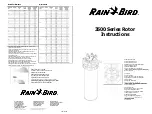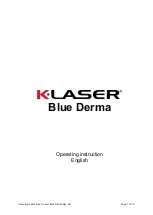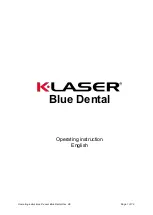
FISHING WITH yOUR DOWNRIGGER
After programming your Digi-Troll, release some line from your rod and reel so that the lure is anywhere from 5 to 100 feet
behind the boat. This is called drop back. Attach the fi shing line fi rmly into the line release. Press and hold the down key
to lower the weight to the desired depth as indicated on the display or select a pre-programmed weight depth. Place the
fi shing rod in the rod holder and reel up the slack so that your rod has a slight bend in it. When a fi sh strikes the lure, the
line will separate from the release. Then you will be free to fi ght the fi sh and bring it in on your rod and reel.
MANUAL DESCENT
By turning the clutch knob gently clockwise (toward the boom), you can let your trolling weight descend as fast or as slowly
as you wish. Turning the knob counterclockwise (away from the boom) stops the weight. This gives you control to let it
plunge rapidly or sink slowly to a predetermined trolling depth. With multiple downriggers, you could start all your weights
creeping down, one at a time, and then stop them each in turn.
NOTE: In order to track line out, the Digi-Troll must be turned on.
WARNING: DO NOT TOUCH THE CABLE REEL WHILE THE DOWNRIGGER IS IN USE! Holding or touching the spool while
it is moving may result in moderate to severe injuries.
THE SHORT STOP SySTEM
The Short Stop system is composed of three critical components: the electronic unit, the
reel conductive path, and the trolling weight insulator.
While the downrigger cable is in the water, there is a minute electrical current that fl ows
between the cable and the grounded metal boat components in the water. When the
cable clears the water, this current fl ow will stop. The Short Stop system senses this
interruption and turns off the motor. The trolling weight insulator is used to break the
cable contact to the water while the weight is still in the water. The reel conductive path
allows the circuit path to be made through the structure of the downrigger.
NOTE: It may be necessary to use two trolling weight insulators.
NOTE: Short stop and Positive Ion Control features do not function when spooled with
monofi lament or super lines or if the boat is not properly grounded.
Stopping the weight at water level eliminates the cable strain caused by bouncing
weights or weights hitting the boom end. Stopping at water level will also keep the weight
from hitting the boat hull.
THE POSITIVE ION CONTROL SySTEM
Your boat has an electrical charge around the hull in water. If a boat is properly grounded and has a proper zinc anode, that
charge should be slightly positive when measured from ground to the downrigger cable. Positive Ion Control (PIC) is the use
of electricity to control that charge and its fl uctuation so that it is always maintained at a specifi ed set voltage.
The practice of setting up and maintaining a slight positive charge on fi shing gear has been used by commercial fi shermen
for many years. This practice has enabled some fi sherman to increase yield when used along with other good fi shing and
boating practices.
Cannon’s electric downriggers offer fi shermen a big advantage in being able to stabilize and control the positive charge
around their boat. Because of the composite construction of the frame, Cannon downriggers are insulated from your boat’s
hull charge.
When the stainless steel downrigger cable is lowered into the water, the natural ionization between the cable and the
boat creates a positive charge of 0.7 to 0.9 volts in saltwater and 0.3 to 0.6 volts in fresh water. This natural voltage is
dependent upon salinity and mineral content of the water. Your actual voltage may vary.
Cable Terminator
Weight Insulator
OPERATING THE DOWNRIGGER












































